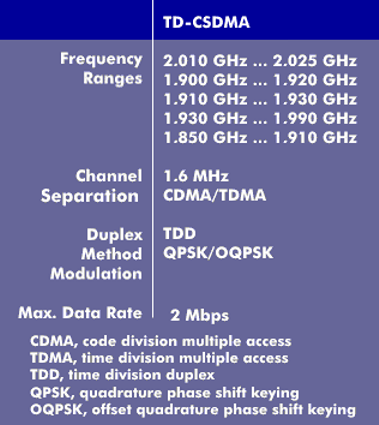time division synchronous code division multiple access (encoding) (TD-SCDMA)
Time Division Synchronous Code Division Multiple Access (TD-SCDMA) is a UMTS transmission method developed by Siemens IC Mobile and the China Academy of Telecommunications Technology, which was published by the International Telecommunication Union( ITU) and is used internationally within the UMTS standard on an equal footing with the other technologies Frequency Division Duplex ( FDD) and Time Division Duplex( TDD) for UMTS.
The TD-SCDMA method is a combination of Code Division Multiple Access( CDMA) and Time Division Multiple Access( TDMA), with the "S" indicating synchronous mode. In this method, all base stations operate synchronously. The TD-SCDMA standard allows particularly good utilization of the frequency spectrum and outperforms competing technologies in terms of quality of service and radio range. The method is also suitable for unpaired transmission channels.
Various frequency bands 1.85 GHz and 2.01 GHz are available for TD-SCDMA technology; the channel spacing is 1.6 MHz. Media access can be made with CDMA or TDMA, and TD-SCDMA uses Quadrature PhaseShift Keying( QPSK) and Offset Quadrature Phase Shift Keying( OQPSK) as modulation. Data rates peak at 2 Mbit/s.
The acceptance of TD-SCDMA is ensured because the method not only works with the UMTS transmission methods Frequency Division Duplex (FDD) and Time Division Duplex (TDD), but also with GSM.

